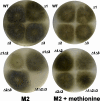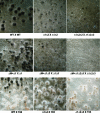PaTrx1 and PaTrx3, two cytosolic thioredoxins of the filamentous ascomycete Podospora anserina involved in sexual development and cell degeneration
- PMID: 17933907
- PMCID: PMC2168258
- DOI: 10.1128/EC.00083-07
PaTrx1 and PaTrx3, two cytosolic thioredoxins of the filamentous ascomycete Podospora anserina involved in sexual development and cell degeneration
Abstract
In various organisms, thioredoxins are known to be involved in the reduction of protein disulfide bonds and in protecting the cell from oxidative stress. Genes encoding thioredoxins were found by searching the complete genome sequence of the filamentous ascomycete Podospora anserina. Among them, PaTrx1, PaTrx2, and PaTrx3 are predicted to be canonical cytosolic proteins without additional domains. Targeted disruption of PaTrx1, PaTrx2, and PaTrx3 shows that PaTrx1 is the major thioredoxin involved in sulfur metabolism. Deletions have no effect on peroxide resistance; however, data show that either PaTrx1 or PaTrx3 is necessary for sexual reproduction and for the development of the crippled growth cell degeneration (CG), processes that also required the PaMpk1 mitogen-activated protein kinase (MAPK) pathway. Since PaTrx1 PaTrx3 mutants show not an enhancement but rather an impairment in CG, it seems unlikely that PaTrx1 and PaTrx3 thioredoxins participate in the inhibition of this MAPK pathway. Altogether, these results underscore a role for thioredoxins in fungal development.
Figures





Similar articles
-
A non-Mendelian MAPK-generated hereditary unit controlled by a second MAPK pathway in Podospora anserina.Genetics. 2012 Jun;191(2):419-33. doi: 10.1534/genetics.112.139469. Epub 2012 Mar 16. Genetics. 2012. PMID: 22426880 Free PMC article.
-
Saccharomyces cerevisiae Cytosolic Thioredoxins Control Glycolysis, Lipid Metabolism, and Protein Biosynthesis under Wine-Making Conditions.Appl Environ Microbiol. 2019 Mar 22;85(7):e02953-18. doi: 10.1128/AEM.02953-18. Print 2019 Apr 1. Appl Environ Microbiol. 2019. PMID: 30683739 Free PMC article.
-
IDC1, a pezizomycotina-specific gene that belongs to the PaMpk1 MAP kinase transduction cascade of the filamentous fungus Podospora anserina.Fungal Genet Biol. 2007 Dec;44(12):1219-30. doi: 10.1016/j.fgb.2007.04.005. Epub 2007 Apr 19. Fungal Genet Biol. 2007. PMID: 17517525
-
Calorie restriction in the filamentous fungus Podospora anserina.Exp Gerontol. 2010 Aug;45(7-8):516-24. doi: 10.1016/j.exger.2010.01.002. Epub 2010 Jan 11. Exp Gerontol. 2010. PMID: 20064602 Review.
-
Impact of ROS on ageing of two fungal model systems: Saccharomyces cerevisiae and Podospora anserina.Free Radic Res. 2006 Dec;40(12):1350-8. doi: 10.1080/10715760600921153. Free Radic Res. 2006. PMID: 17090424 Review.
Cited by
-
New insights from an old mutant: SPADIX4 governs fruiting body development but not hyphal fusion in Sordaria macrospora.Mol Genet Genomics. 2017 Feb;292(1):93-104. doi: 10.1007/s00438-016-1258-0. Epub 2016 Oct 21. Mol Genet Genomics. 2017. PMID: 27770259
-
Gene replacement in Penicillium roqueforti.Curr Genet. 2015 May;61(2):203-10. doi: 10.1007/s00294-014-0456-8. Epub 2014 Oct 15. Curr Genet. 2015. PMID: 25315520
-
The genome sequence of the model ascomycete fungus Podospora anserina.Genome Biol. 2008;9(5):R77. doi: 10.1186/gb-2008-9-5-r77. Epub 2008 May 6. Genome Biol. 2008. PMID: 18460219 Free PMC article.
-
Thioredoxin VdTrx1, an unconventional secreted protein, is a virulence factor in Verticillium dahliae.Front Microbiol. 2023 Mar 31;14:1130468. doi: 10.3389/fmicb.2023.1130468. eCollection 2023. Front Microbiol. 2023. PMID: 37065139 Free PMC article.
-
Thioredoxin and Glutaredoxin Systems Required for Oxidative Stress Resistance, Fungicide Sensitivity, and Virulence of Alternaria alternata.Appl Environ Microbiol. 2018 Jul 2;84(14):e00086-18. doi: 10.1128/AEM.00086-18. Print 2018 Jul 15. Appl Environ Microbiol. 2018. PMID: 29752269 Free PMC article.
References
-
- Altschul, S. F., W. Gish, W. Miller, E. W. Myers, and D. J. Lipman. 1990. Basic local alignment search tool. J. Mol. Biol. 215:403-410. - PubMed
-
- Ausubel, F. M., R. Brent, R. E. Kingston, D. D. Moore, J. G. Seidman, J. A. Smith, and K. Strul (ed.). 1987. Current protocols in molecular biology. Wiley Interscience, New York, NY.
-
- Brygoo, Y., and R. Debuchy. 1985. Transformation by integration in Podospora anserina. I. Methodology and phenomenology. Mol. Gen. Genet. 200:128-131.
-
- Byun, H. S., E. W. Cho, J. S. Kim, M. S. Moon, J. J. Yum, K. C. Kim, and I. G. Kim. 2005. Thioredoxin overexpression in HT-1080 cells induced cellular senescence and sensitization to gamma radiation. FEBS Lett. 579:4055-4062. - PubMed
-
- Coppin, E., and P. Silar. 2007. Identification of PaPKS1, a polyketide synthase involved in melanin formation and its use as a genetic tool in Podospora anserina. Mycol. Res. 111:901-908. - PubMed
Publication types
MeSH terms
Substances
LinkOut - more resources
Full Text Sources

